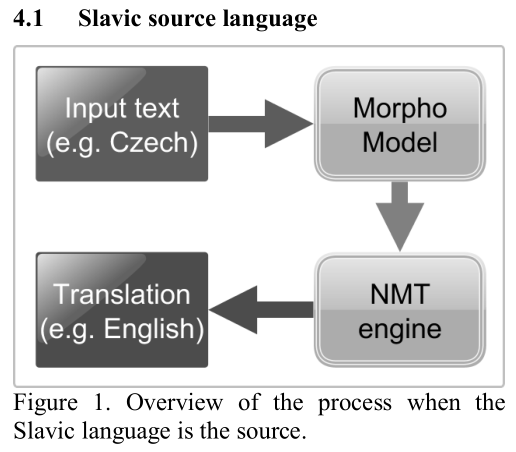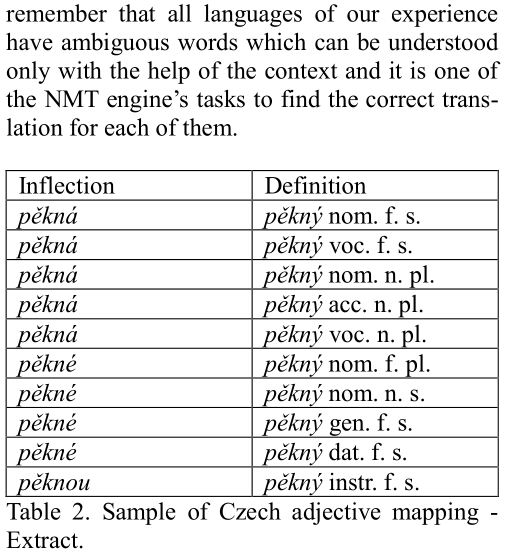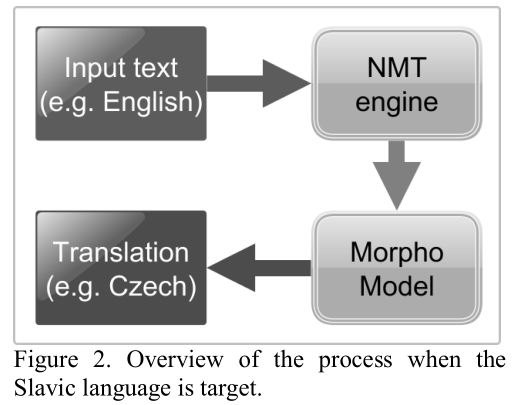 |
 |
 |
 |
| MT reshaping the language industry |
| 08 | Morphological Neural Processing for Slavic Languages | |
|---|---|---|
|
1. Overview of the process when the Slavic language is the source. When translating from a Slavic language, the Morpho Model must parse an inflected word into its grammatical information so that the engine has everything it needs to translate properly. |
Morphological Neural Pre- and Post-Processing for Slavic Languages
Since we are working with Slavic languages as either the source or the target, the Morpho Model is used in both directions; 1. Overview of the process when the Slavic language is the source. 
|
|
Tři tvary slova "pěkný"
Test results 2 involving only the Morpho Model show that when the Slavic language is the source language, the percentage of perfect matches 3 is around 80%. This value is perfectly respectable, considering that the remaining non-perfect matches may fall into one of three categories: While the first two cases may cause a degree of confusion and lower the final BLEU evaluation, only the third one actually represents a disturbing factor when used as input for the incoming translation engine. In any case, we can observe quite astonishing results in the opposite direction (i.e. Slavic as the target language), where the perfect match rate is over 90% for Russian, and even 97% for Polish. |

|
|
|
4.2 Slavic target language When translating into a Slavic language, the Morpho Model is employed from the definition to the inflection. In this case, the engine plays a dominant role. In fact, its translation constitutes the input for the Morpho Model, and it must be extremely reliable in order to correctly build the final word. Consequently, particular care is required when selecting the tokens to be sent to the Morpho Model (it works at word level, so it needs one stem and several properties to generate one inflected form). There is a risk of creating incorrect or even artificial words at the end of the process, but our tests show that this risk is minimal. |

|
|
| Tvarosloví |
Software extrahuje terminologii z textů, které má uživatel k dispozici.
Čeština má zpracovanou gramatiku a v ní jsou uvedeny všechny možné spisovné tvary slov.
Wiktionary.org/wiki/ slovo "pěkný" obsahuje. Tvary slova jsou v češtině a například ve francouzštině. |
|
https://cs.wiktionary.org/wiki/p%C4%9Bkn%C3%BD
skloňování| Číslo | singulár | plurál |
| Rod | mužský životný | mužský neživotný | ženský | střední | mužský životný | mužský neživotný | ženský | střední |
| 1. | nominativ | pěkný | pěkný | pěkná | pěkné | pěkní | pěkné | pěkné | pěkná |
| 2. | genitiv | pěkného | pěkného | pěkné | pěkného | pěkných | pěkných | pěkných | pěkných |
| 3. | dativ | pěknému | pěknému | pěkné | pěknému | pěkným | pěkným | pěkným | pěkným |
| 4. | akuzativ | pěkného | pěkný | pěknou | pěkné | pěkné | pěkné | pěkné | pěkná |
| 5. | vokativ | pěkný | pěkný | pěkná | pěkné | pěkní | pěkné | pěkné | pěkná |
| 6. | lokál | pěkném | pěkném | pěkné | pěkném | pěkných | pěkných | pěkných | pěkných |
| 7. | instrumentál | pěkným | pěkným | pěknou | pěkným | pěknými | pěknými | pěknými | pěknými |